Editor’s Note: This article was originally published in Overland Journal, Gear Guide 2018. Photography by Alfonse Palaima, Scott Brady, and Colin Evans
Expedition 65 was not a tour; it did not even have a leader. While some might view that as a recipe for ending friendships, it played into a grand experiment and ultimately a transformative experience. The concept was born from a rushed trip to Bolivia and became a very rushed trip all the way to Ushuaia. Here is the hard reality of travel: there is never enough time—ever. That is how life works. However, there is more that can be gained from adventure, like the rapport established with those we ride with, and the changes to our notions of the world, shifted by the perceptions that form by actually being there. This is a story of those insights and those friends, with a bit of adventure thrown in for good measure.
#EXPEDITION65
We had a hashtag; now we needed a plan. We were a dozen friends bringing their different skills, life experiences, and personalities to execute a ride. It was decided to ship the bikes to Cartagena, Colombia, ride to Ushuaia, Argentina, and then ship everything back home from Punta Arenas, Chile. From the Caribbean to the Antarctic, 10 degrees north of the equator to 55 degrees south. Over 10,000 miles through six countries, with 13 border crossings. The scale was huge and overwhelming, but it turned out to be the ordinary encounters that made the most impact.
A NEW FRIEND
I came to South America to meet South Americans. We arrived in Huamachuco in the Northern Highlands of Peru looking for lunch, a place to rest, and time to plan our next steps. We found a restaurant on the town plaza and, across the street, a couple of old gentlemen watched the world go by as they probably did most days.
We were soon answering questions from onlookers around our bikes. Who were we, where were we from, where were we going? But these gentlemen remained reserved and distant, their old-fashioned manners making it impolite to intrude. So I went over and sat on their wall and chatted and found out that Fernando and Cesar were farm workers who had retired long ago; they had the same questions as everyone else but were too dignified to ask. Fernando took a photo of me with his ancient cell phone and proudly welcomed me to his town surrounded by hard farming and toxic mining. He was way too old for a photo on the bike but wanted a picture with me and asked for a copy. I asked for his address, but he pointed to Foto Rodriguez on the corner of the plaza. A few minutes later, with the card from my camera, Señor Rodriguez produced two 4×6 glossy photos for which he adamantly refused payment. Fernando took the photo with dignity but without a smile. In the street, he unexpectedly hugged me and went on his way. We had both made each other’s day very special.

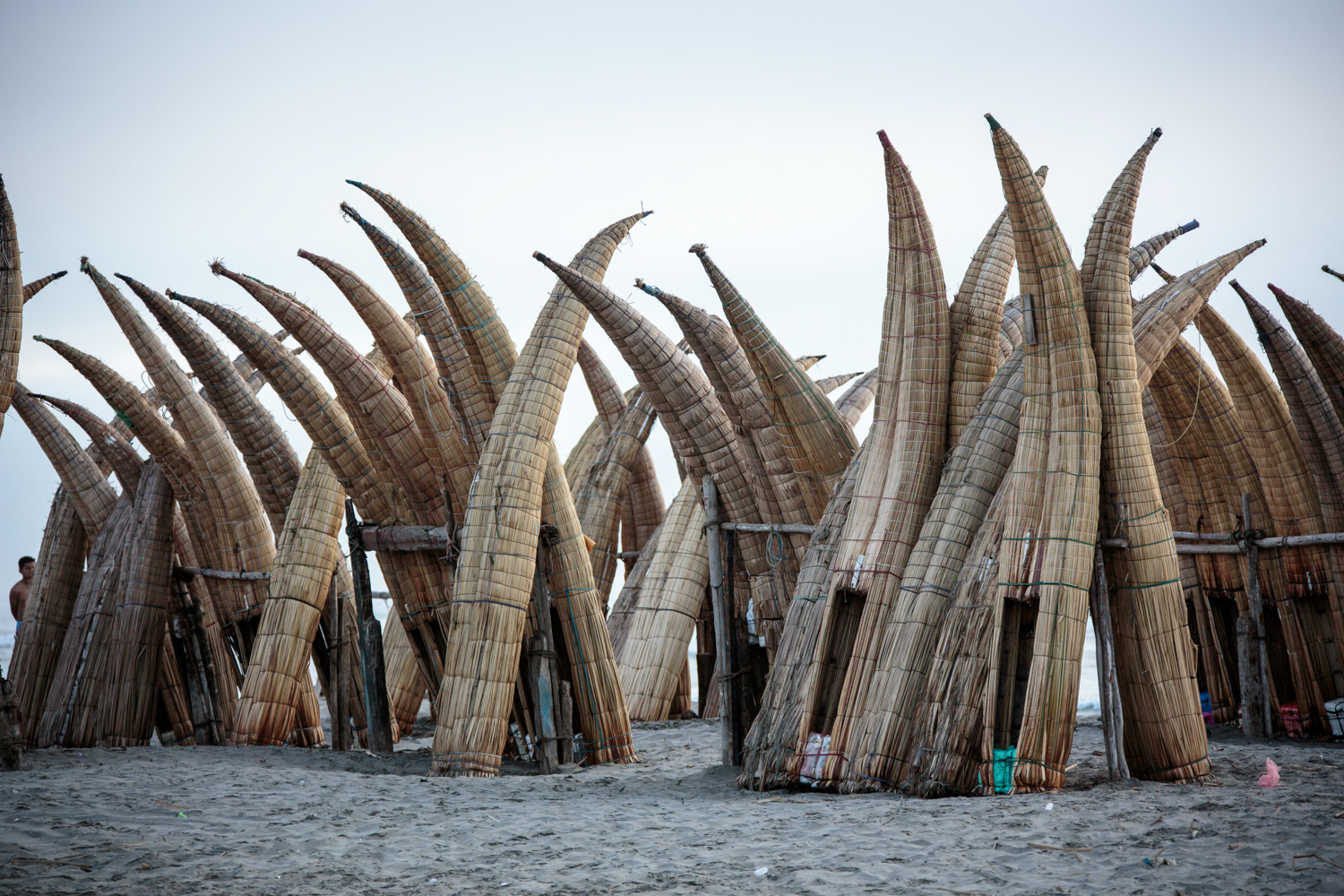
DIFFERENT JOURNEYS
Adventure motorcycling brings together people of significantly different political and personal beliefs around a common passion. We had one idea but many different expectations and motivations: escape, adventure, discovery. The scariest roads or intimate personal encounters. If another member of the group wrote this account, it would be an entirely different story. For me, it was a journey to experience six countries, explore a thousand years of history, and learn something about myself. It wasn’t just about the terrifying roads, spectacular scenery, new food, smells, and people—but about new perspectives, camaraderie, and challenges that ultimately revealed how lucky we are to have been born where and when we were. At the start we all half knew each other, but in months of shared experiences you inevitably reveal more of yourself, and at the end, we were brothers. Nobody was in charge, but everybody took responsibility.
HOW TO THROW A PARTY
Angasmarca is an unremarkable town in the Central Highlands of Peru. There are no pre-Incan ruins, no Spanish colonial buildings, no handicrafts markets. Just a small concrete plaza separated from any passing tourists by difficult dirt roads over almost impenetrable mountains.
But we rode into Angasmarca on the town’s birthday, the annual celebration of its founding. Our path was blocked on every street. As we stopped to see what was happening, it seemed that every school, church, civic organization, and indigenous group was parading for the rest of the town—marching, singing, dancing, and being applauded from a sea of leather-like faces and enormous straw hats.
Very soon, the curious kids and more adventurous adults came over to chat with us, and a conversation started about why we were in their town this lovely Sunday afternoon. Then came the photographs, well wishes, welcomes, giggles, and the general breaking down of barriers that happens every time we stay long enough.
As we were getting ready to leave, a couple of groups of people appeared dressed in their traditional colors carrying palm fronds, each led by a man in a knitted mask with holes for eyes and mouth. Suddenly we were surrounded and pulled in by one of the masked leaders with a rope in the form of a snake. When we tried to extract ourselves, we learned that it was considered rude to leave before the song was finished, but we had to go. This was no place to be riding at night. Finally, a police officer with an ancient revolver helped steer away the people so we could ride and not hurt anyone. Angasmarca, we will be back on your next birthday.
THE MOST DANGEROUS ROAD
Riding in the Andes is breathtaking, electrifying, and completely terrifying. Leaving Pallasca, we dropped 7,000 feet into the Rio Tablachaca Valley, on roads where there was zero room for error—one slip and there was the abyss.
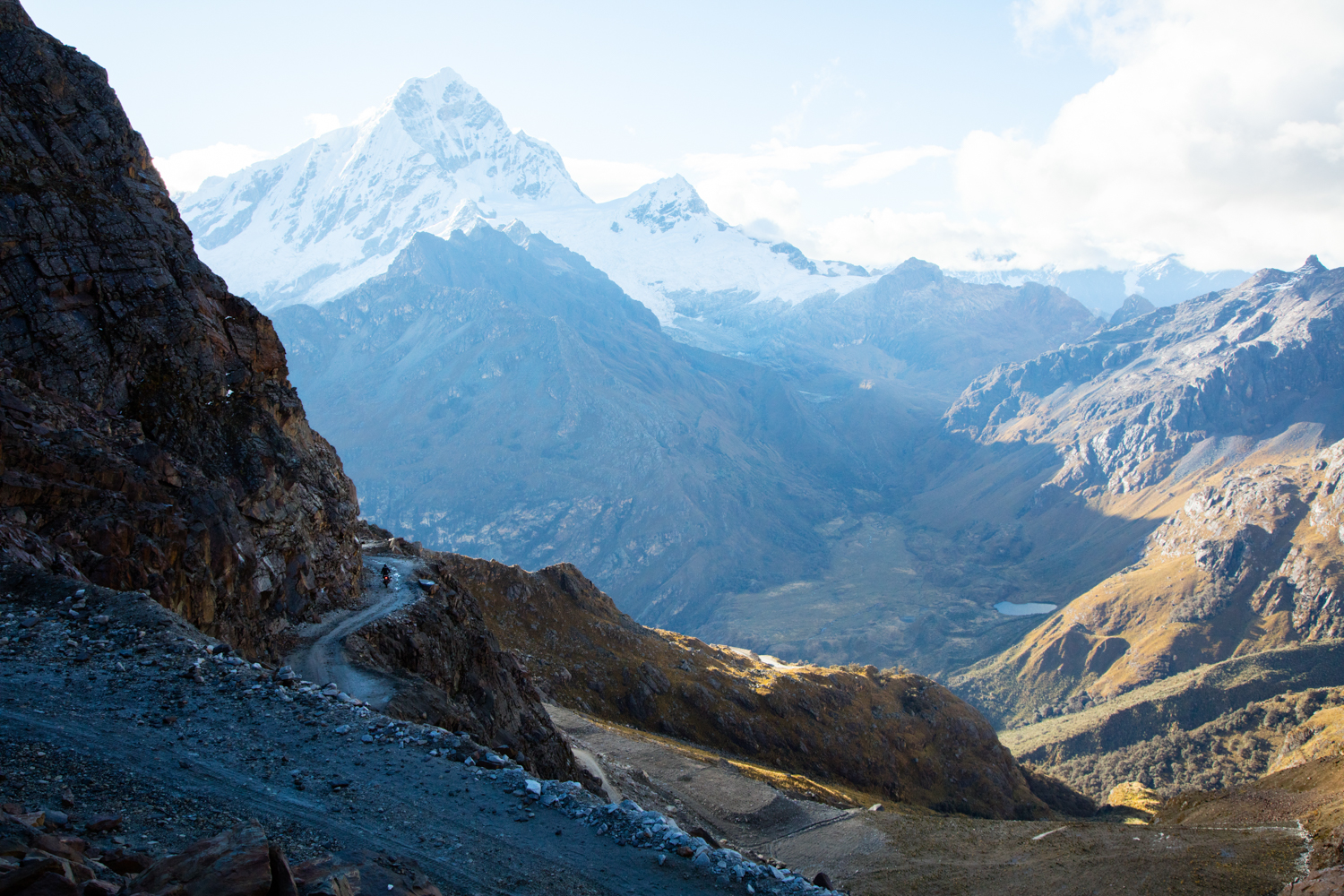
This road was once paved, but now large sections have slipped away after landslides or earthquakes and have been crudely patched. Even on sections that are still intact and paved, trucks and buses have ripped every hairpin bend into potholes, and huge sections have a mound of pebbles and scree in the center of the road. This is no problem for trucks, but a nightmare for motorbikes. You cannot look at the road and the scenery at the same time here, even for a second.
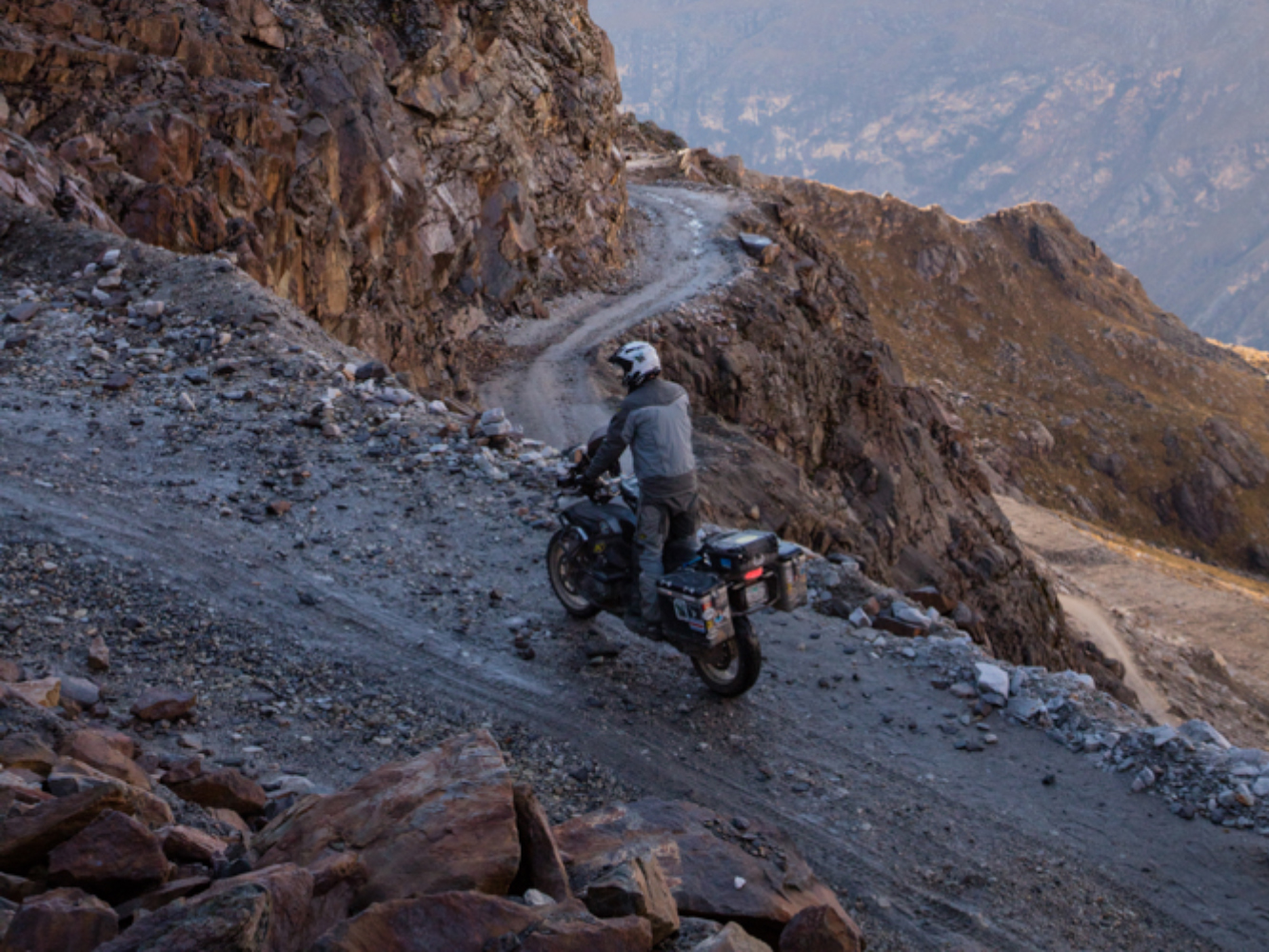
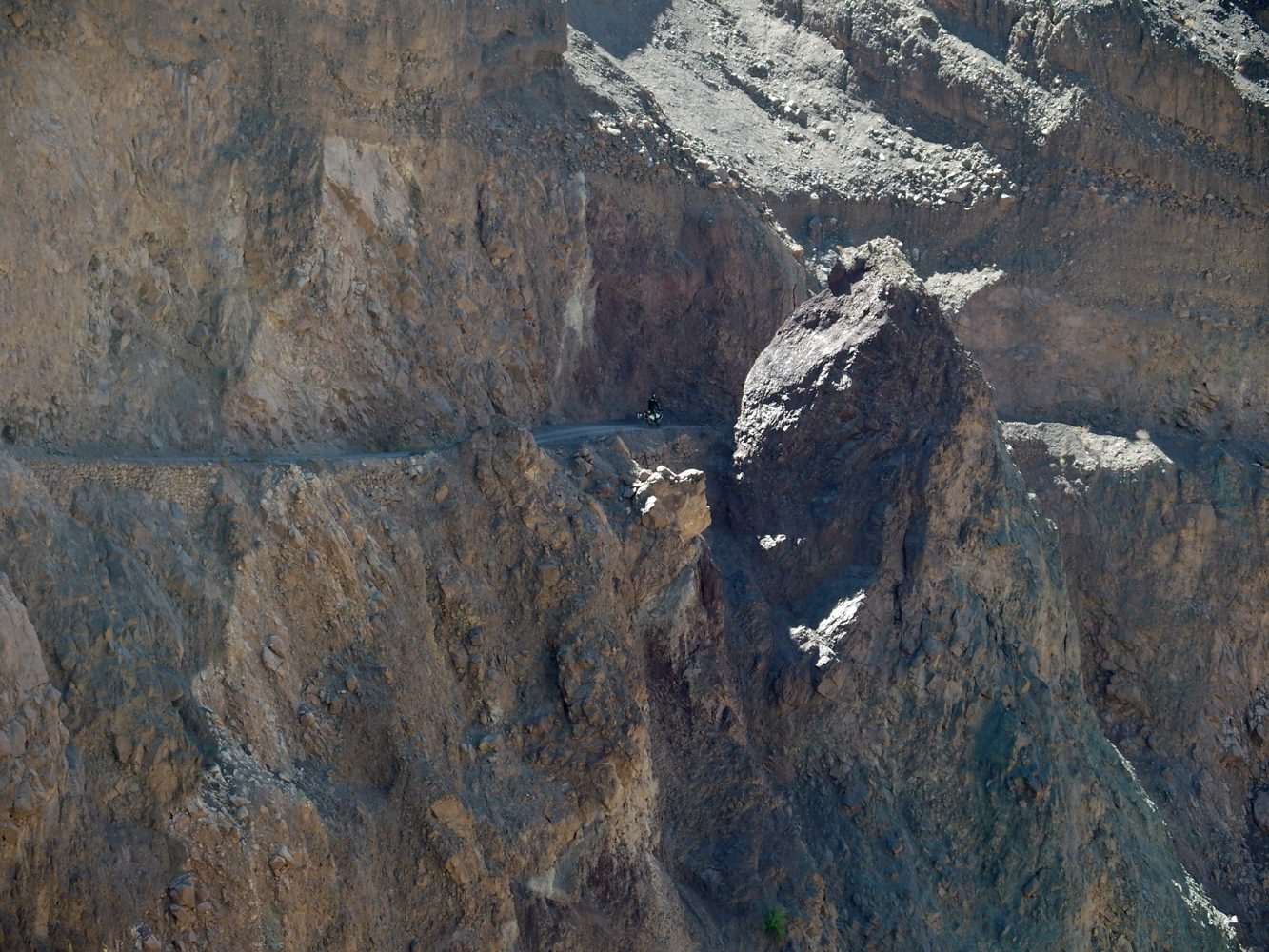
LAND OF CONTRASTS
Traveling in South America is a constant battle between the outstanding natural beauty and the choking poverty and pollution of the towns and cities. Municipalities are overrun with farm animals, construction and detours everywhere, roads jam-packed with ubiquitous passenger vans shuttling people in all directions, and buses and trucks with unmaintained diesel engines spewing carcinogens in indiscriminate black clouds.
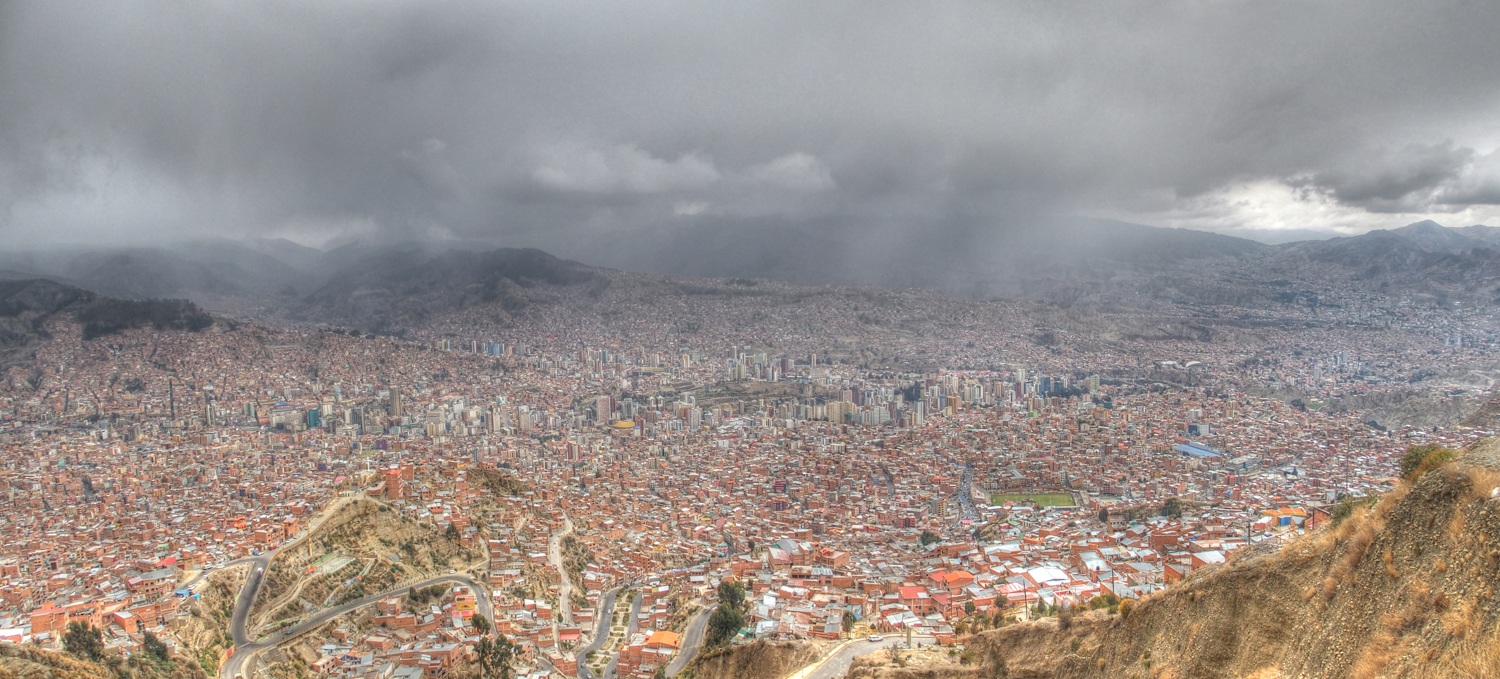
La Paz, Bolivia, is a perfect example. There is no city in the world more visually stunning than La Paz; it sits in a canyon that has protected it from Altiplano winds and the worst of the high altitude weather for centuries—the views of the city are amazing. It was originally a small mining town before the Spanish showed up and took over. Today, it is spilling further and further down the canyon with unplanned building continuing on every slope.

But the combined population of La Paz and neighboring El Alto is over 2.3 million people, and they are crammed into a place with no level ground, money, or ability to create effective public transportation. When we arrived in El Alto, the main road to La Paz was dug up for over 5 kilometers, and we resorted to riding our big BMW bikes along the roadworks at dusk, trying not to strike the puzzled onlookers who scurried out of the way.
It seems that the citizens of El Alto are fed up with the roadworks too. Every road was blocked with peaceful demonstrations by local lady organizers in bowler hats, carrying children and provisions in their shawls, campaigning against the mayor. Less money on roads and more money on education was the basic message.
BEAUTY VERSUS REALITY
Of the countries visited on this journey, Bolivia is by far the poorest with a GDP per capita one-tenth of the U.S. It is safe to assume that most of the people we met riding through the Cordillera Quimsa Cruz south of La Paz are living lives that are economically well below their average countrymen. Many are likely living on subsistence farming and are not even counted in the GDP because they generate no economic activity.
South of La Paz, we rode along the Río Choqueyapu through a valley of small farms and then climbed up the first of a number of spectacular mountain passes where people were scratching a living on ever smaller and higher terraces. Mountains and valleys fill the horizon for hundreds of miles around the snow-capped Illimani, the highest mountain in the Cordillera Real.
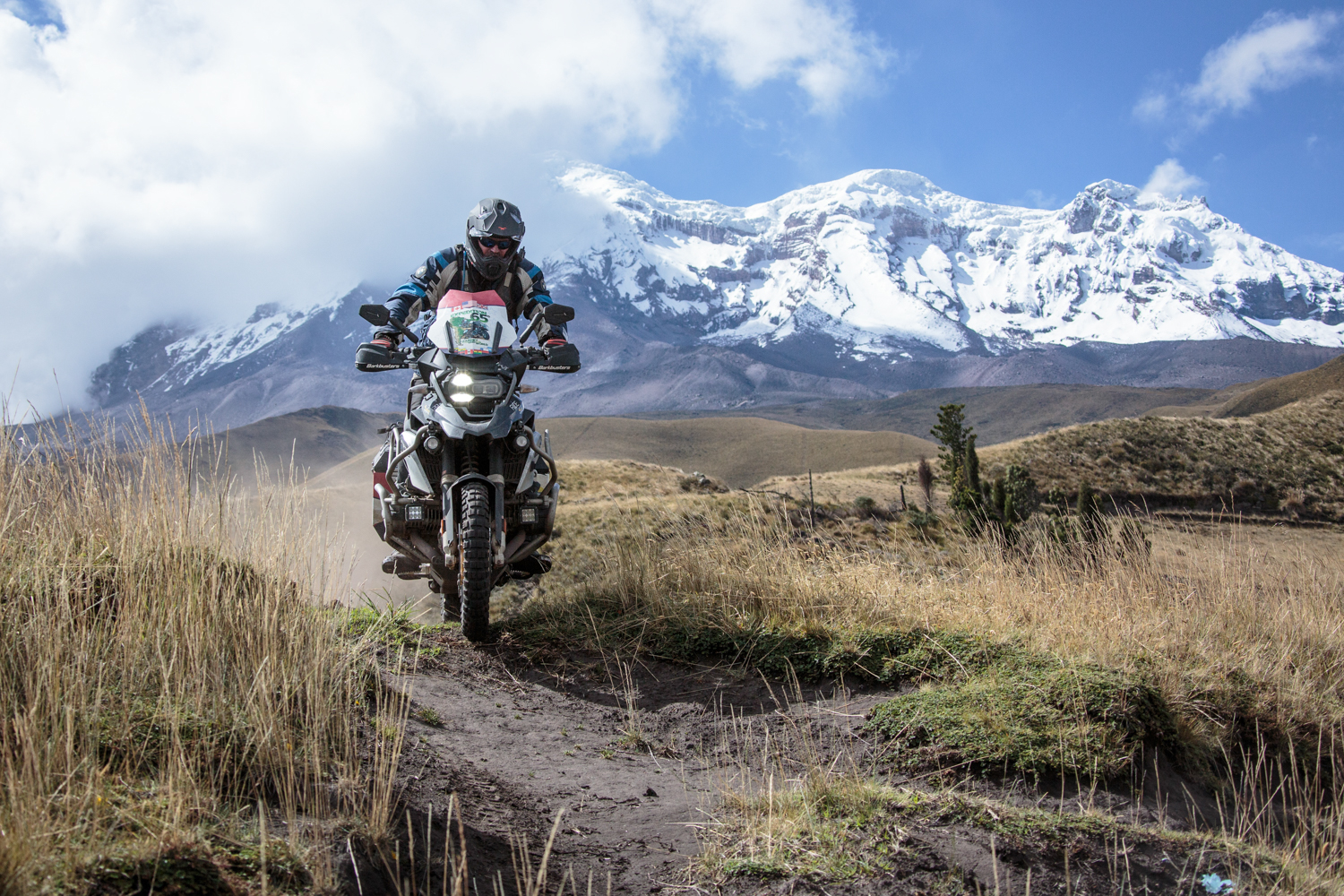
The road was dirt but well maintained, and we shortly came across a large road crew grading and repairing the surface. When they saw a group of gringos on large bikes, they decided that this was too good an opportunity to miss and blocked our path demanding a toll—literally, highway robbery. After a lot of back and forth we settled on 50 bolivianos (about $8), paid to the old man leading the negotiation. There were at least 20 men in this group so we have no idea how the bounty was divided up. We heard later that this likely went into a community fund, but I’m not convinced.
NO HISTORY, NO FUTURE
On our first night out of La Paz, we stayed in the guesthouse and bunkhouse on Tenería Ranch, which has been in the family of Hans Hesse for many generations. He and his family welcomed us with open arms and made a fantastic dinner of roast pork, local vegetables, and fresh bread—all from their huge outdoor baker oven.
Don Hans and I chatted for a while as a test of his patience and my Spanish. Hans was born on this farm 80-odd years ago and only spoke Aymara learned from his grandmother until age 7. He moved to La Paz to go to college and then moved to Germany where he worked for a manufacturer of heavy lifting machinery in the docks at Kiel. He retired at 46 and because pension was not paid until age 65, he moved back to the family farm where it was cheaper to live.
He told me about his four kids, his Chinese motorbike that he still rides everywhere, and the buildings on the farm that dated back 600 years. Hans bemoaned the fact that the original buildings, whose foundations still poked through the grass, had been perfectly aligned to catch the winter and summer sun on different walls, but were torn down anyway.
He then described the family memorial in the center of the property which predates the arrival of the Spanish; it was originally Aymara, then converted to Quechua, and finally extended to accommodate Catholicism to include a cross and a small niche for a statue of the Virgin Mary. Hans told me that the bones of many of his ancestors on his mother’s side are interred here, as he expects his to be when the time comes. I thanked him for taking the time to share his stories and family history. He thanked me graciously for taking an interest, ending our conversation with “Sin historia, no futura.”
LEGENDARY WINDS
There is simply not enough land mass in the narrow point of South America to slow the “Roaring Forties” winds at these latitudes of Patagonia. The winds are stronger than the same winds in the northern hemisphere because they have been blowing over water with no interruption for so long and so far. This is the most southerly bit of land that dares to poke out into these storms.
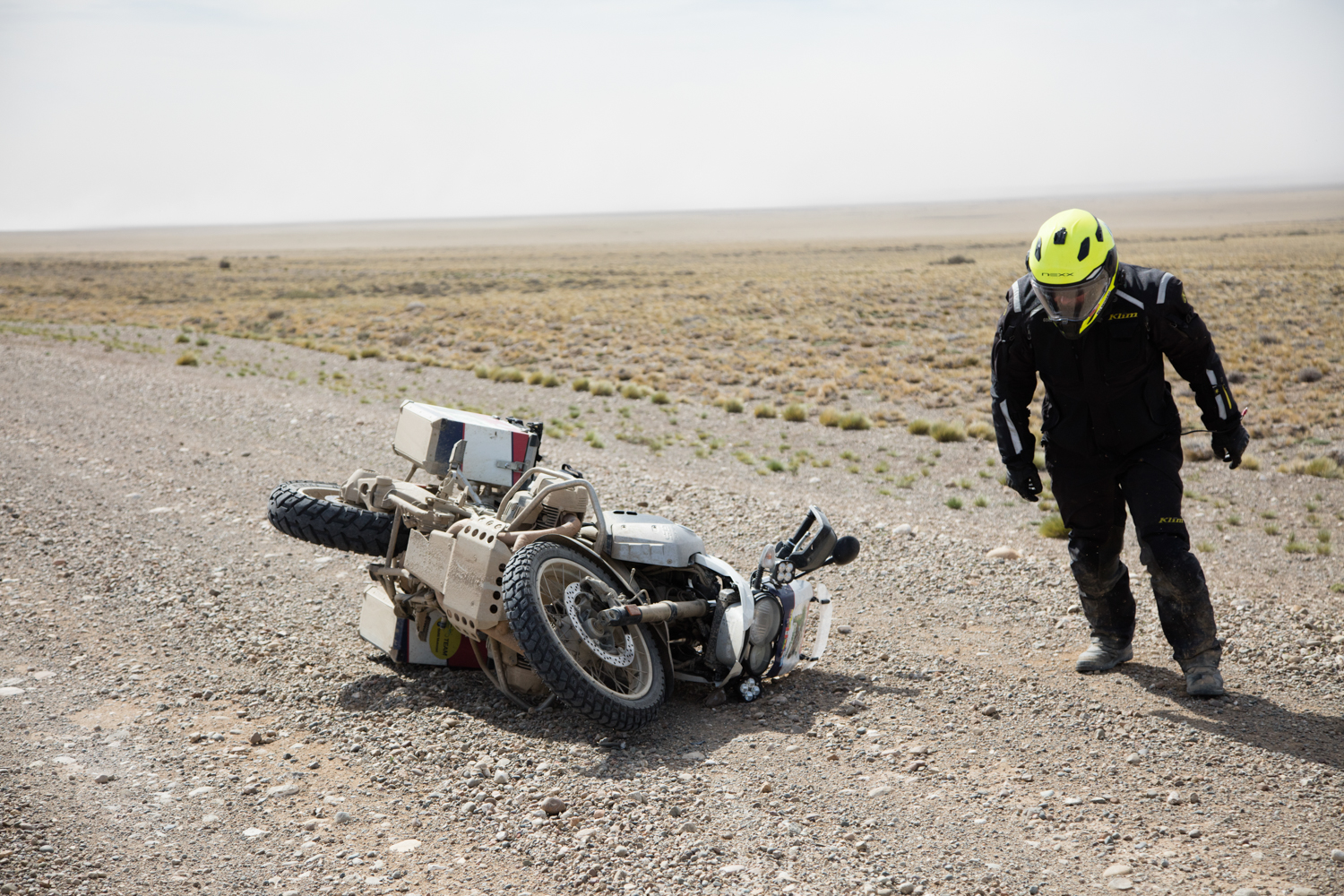
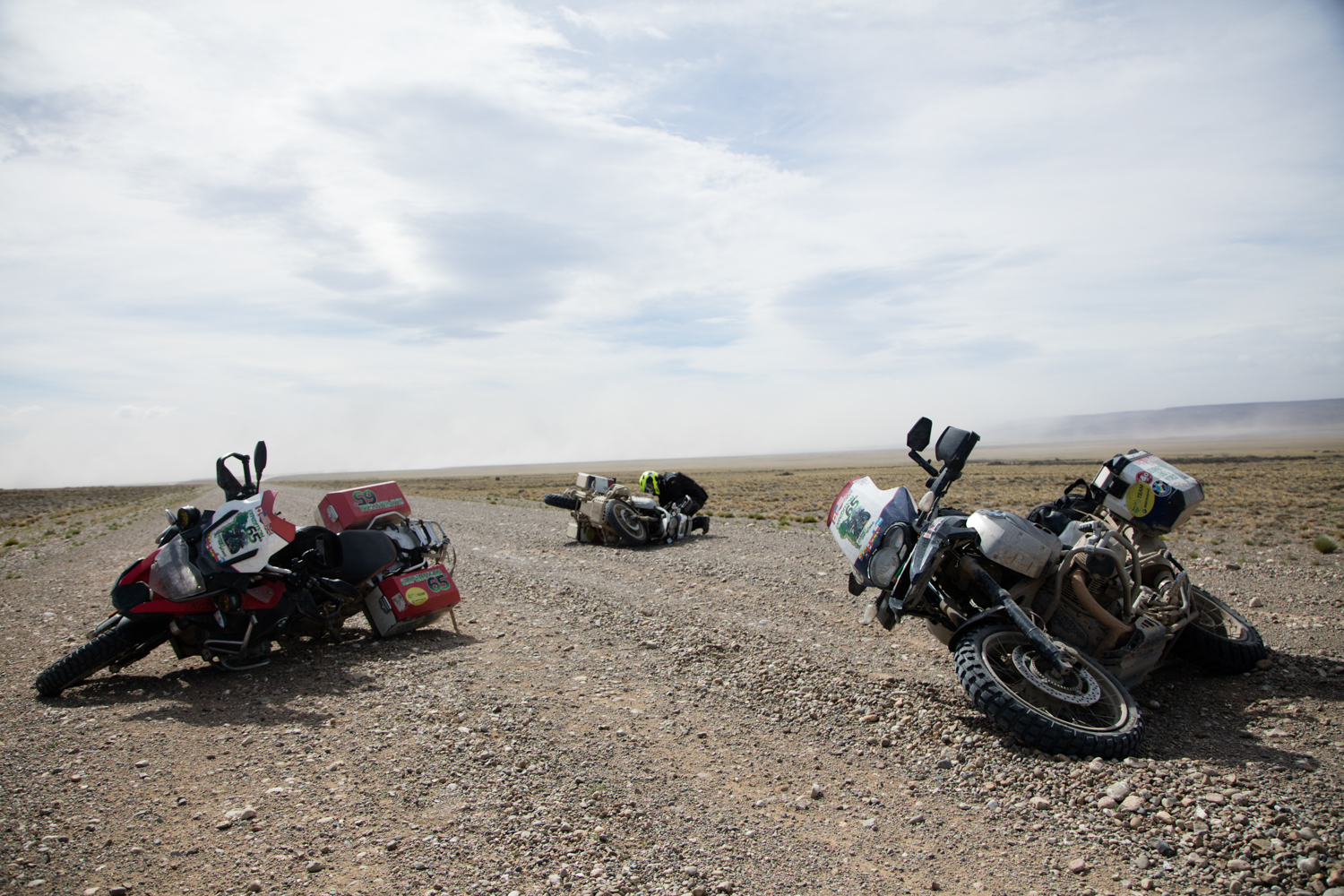
There is normally a constant 25-mph wind blowing, but riding along this part of Ruta 40 became completely impossible when the local weather service reported sustained 75-mph winds. When there was a road surface like tarmac or solid rock with some grip, it was feasible to lean the bike, but when there was fresh gravel it was impossible to resist the sideways force— you cannot lean the bike far enough without losing all grip. All of us went down or got knocked off the road. If you parked your bike with the side stand upwind, it was knocked over instantly.
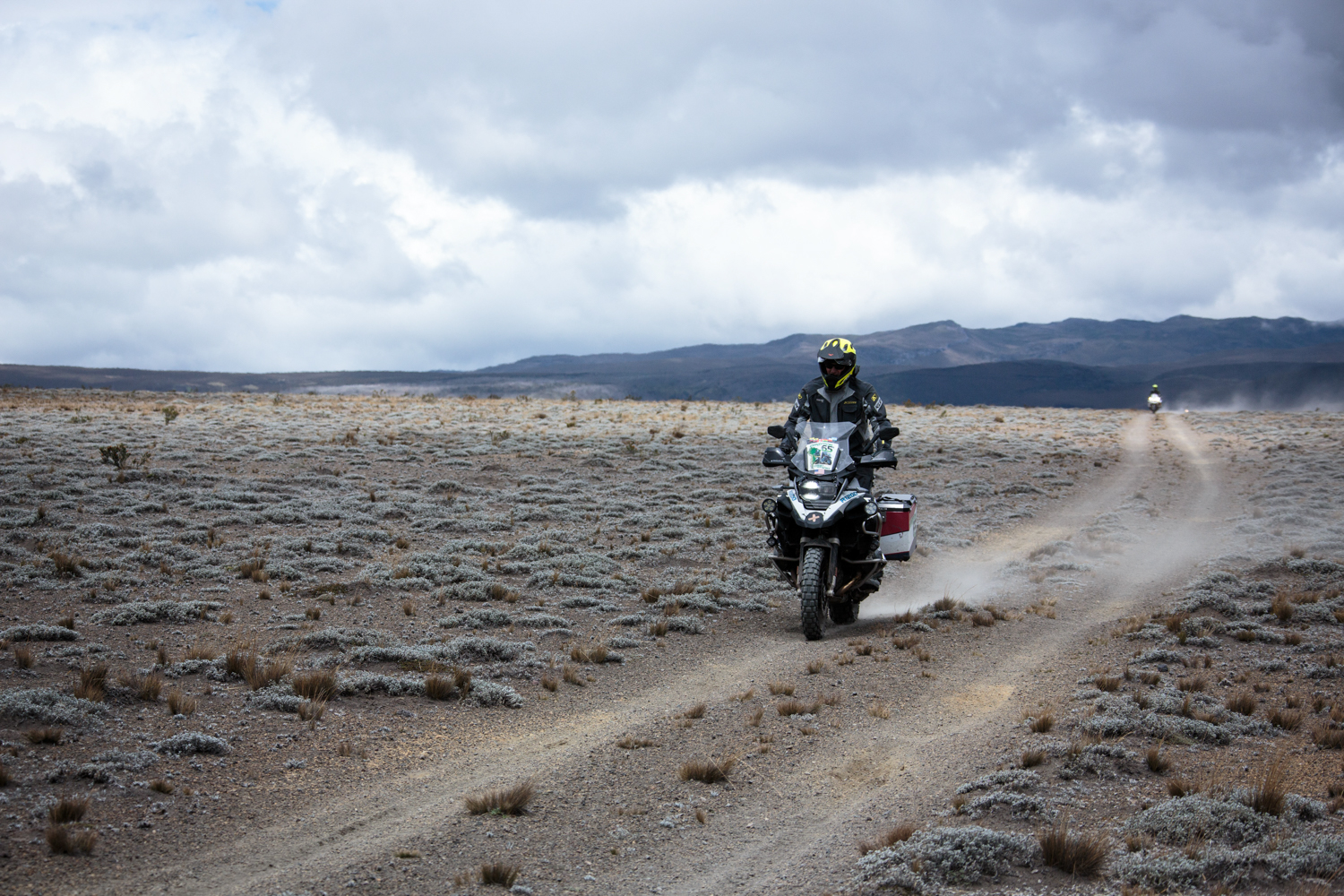
Everyone seemed to invent their own technique for dealing with this: let the bike drift and then lurch upwind periodically, lean way off to windward to keep the bike vertical, go fast enough that the wheels gave more gyroscopic help—physics won every time though.
HONOR THOSE WHO SERVED
My father was conscripted in 1943 and joined the British Army Corps of Signals; he then volunteered to join the new Airborne Division. He missed the action in Europe and was sent to Palestine as part of the British Mandate and served as a Red Beret until he was demobilized in 1948. His contemporaries returned home to a hero’s welcome after the defeat of Germany, but he returned unheralded after a perceived defeat in Palestine and was never the same afterward.
Many who fought for Argentina in the Falklands War must have felt the same way. We visited the Monumento a Los Héroes de Malvinas in the naval town of Río Grande in Tierra del Fuego, Argentina. As we stopped for photographs in the cold, cutting Atlantic gale, we were greeted by José Salas who is one of 120 Malvinas veterans who maintain a vigil at the monument to honor the fallen and the veterans of this needless conflict. There is one link in the chain around this monument for each of the 648 Argentinian dead.
He handed us stickers and then led us to the museum that is self-funded by the veterans in town. We discussed his experience and that of my Dad, and he was very careful to point out that the monument and museum are not there to point blame at the British, but to remember their old friends.
FOLLOWING PLAN B
A motorbike forces a different relationship between travel and traveler. Riding requires complete commitment and concentration. The motorcycle demands that you observe your world much more closely, to soak up every detail for safety, so it all connects immediately and permanently to your cerebral cortex. Arriving on a moto creates a disturbance from the ordinary for the people we meet; it forces a conversation and creates a real personal impact. It amplifies sensations with moments of complete delight and satisfaction from conquering long distances and difficult roads, but with hundreds of moments of absolute terror, discomfort, and pain. We planned every step of the way, but it was the unplanned steps that defined our experience.
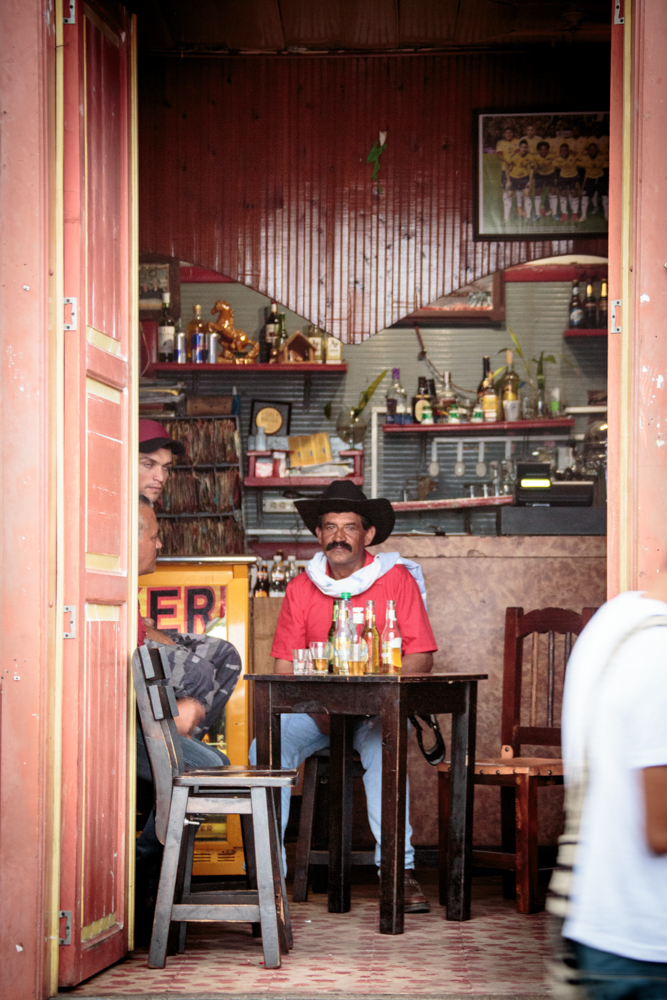


No comments:
Post a Comment